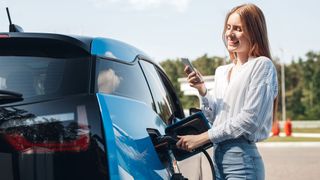Google Maps just got a major update for EV drivers
Google Maps just got a little more useful for electric vehicle drivers who desperately need a charging station.
If you now use Google Maps in Android Auto to navigate and your car is set up as an EV in your app settings, it will no longer recommend gas stations at the top of the Categories menu. Instead, you’ll see charging stations in pole position – a much more convenient option for drivers of vehicles that don’t need petrol.
The Categories menu gives you a shortcut to search for all nearby locations that fit into a specific category, such as restaurants, groceries, coffee or gas stations, and charging stations to name a few. Tap on one of the categories and the app will pin and recommend several locations that fit the description of what you’re looking for.
While EV drivers tend to plan trips around charging stations, there will be times when you get caught and need to charge your vehicle unexpectedly. If you’re not familiar with the area you’re driving in, finding a charging point can be a challenge. With this change to the Categories menu, it’s now a lot easier to use Google Maps and find the juice you need.
In addition to telling Google that you have an electric car, you can also inform it about the type of charger required and the charging speed you prefer – information that will further narrow down the list of recommended charging options.
For now, the change appears to be exclusive to the Android Auto version of Google Maps. You can still search for nearby charging stations in the regular Maps app, but the shortcut is harder to find no matter how you set your vehicle preferences.
More EV-friendly features required
This update follows a Google Maps change from last September that allowed the app to adjust its personalized route recommendations to help EV drivers travel more efficiently. Much like how the feature works for other vehicle drivers, Google Maps looks at the data it has and recommends the route it thinks is the most efficient – marking it with a green leaf symbol.
Usually the most efficient route is also the quickest, but if not, the time difference between the two is often minimal – and if you choose the more efficient (albeit slower) route, you will use less fuel or cargo to get from A to B and hopefully save money in the long run.
However, Google Maps still has a way to go. The biggest challenge it has is overcoming the in-vehicle navigation that comes with many electric cars. This built-in system has the advantage of knowing the car’s status and can often automatically update your route based on how much charge your car has left – a feature that Google Maps currently can’t match.

